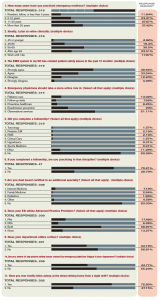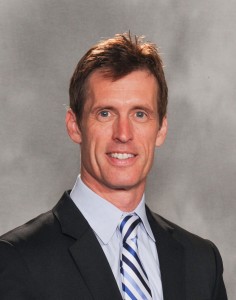
The ACEP Council process is complex, intricate, even a bit messy at times, and yet very functional. Putting 360-plus of the brightest minds in emergency medicine together in a room for two days to discuss, debate, and develop solutions for issues impacting our specialty and our patients is impressive to watch and particularly impressive to participate in. The Council can be thought of as the Congress of emergency medicine, functioning similarly to the British Parliament. Although a great deal of business is addressed during the Council’s annual meeting, perhaps the most critical issues to EM are the elections of our Council Officers, ACEP Board members, and President-Elect and the deliberation and either adoption, nonadoption, or referral (to the Board of Directors for further consideration) of the Council resolutions (similar to congressional bills). The ACEP Board of Directors sets policy, but the ACEP Council guides the initiatives of the Board based on the actions adopted via the resolution process. Resolutions that are adopted by the Council contain actions to be enacted by the Board of Directors. On those rare occasions—I cannot recall one—where the Board does not vote to accept the adopted resolution, a process exists to reconcile the difference of opinion. Below, I have included important excerpts from this year’s meeting: the outcome of all of the Council resolutions; four examples of resolutions and their specific outcomes; and the responses to the Council demographic questions, which are drafted each year to gain insight into important issues facing our specialty.
Explore This Issue
ACEP Now: Vol 33 – No 12 – December 2014Members of the Council, who represent their constituents and their interests, draft Council resolutions. The resolutions are submitted by late summer, and the staff develops detailed background information explaining any previous ACEP activity on the topic, the fiscal impact of the resolveds (the actionable portion of the resolutions), and any other important facts that will aid the Council in its deliberation. The resolutions are then published. On the first day of the Council meeting, the testimony is heard on all resolutions at Reference Committees, which will make the final editorial changes based on the testimony received. The goal of the Reference Committees is to make certain that the resolutions meet the needs of the Council, per the testimony received, and to make a recommendation (adopt, not adopt, or refer) for the outcome of each resolution. As noted below, a summary of the testimony provided accompanies their report on each resolution. Our Reference Committee Chairs, John T. Finnell, MD, FACEP; Kathleen Clem, MD, FACEP; and Howard K. Mell, MD, MPH, FACEP, and their committee members did an outstanding job in conducting this essential part of this year’s meeting.
1 Amended Resolution 12(14) was adopted by unanimous consent agenda. The Reference Committee made the highlighted change and recommended adoption. The consensus was so strongly in favor of adoption, this resolution was added to the unanimous consent agenda. Although any Councillor can extract a resolution from the consent agenda, this one was not extracted and was adopted via unanimous consent.
AMENDED RESOLUTION 12(14) Affiliate Membership Feasibility Study
RECOMMENDATION
Mr. Speaker, your Reference Committee recommends that Amended Resolution 12 be adopted.
RESOLVED, That the ACEP Board of Directors commission a study and report on the feasibility of creating a non-voting, non-office holding membership category for physicians individuals not currently eligible for full, active membership and that this report, including the financial and advocacy impact of membership expansion, be presented to the 2015 Council.
Testimony
Testimony was overwhelmingly in support of the resolution. It was reinforced that the resolution simply calls for the Board of Directors to study the feasibility. Those in favor suggested that ACEP should be inclusive and representative of all emergency medicine providers. Multiple individuals indicated that rural physicians who practice emergency medicine could potentially benefit. It was noted that many other medical specialties have an affiliate membership category.
This is the final resolved adopted by the Council.
Resolution 12 Affiliate Membership Feasibility Study (as amended)
RESOLVED, That the ACEP Board of Directors commission a study and report on the feasibility of creating a non-voting, non-office holding membership category for individuals not currently eligible for full, active membership and that this report, including the financial and advocacy impact of membership expansion, be presented to the 2015 Council.
2 Resolution 22(14) was amended by the Reference Committee, included in the unanimous consent agenda, was not extracted for debate and was adopted.
AMENDED RESOLUTION 22(14): EMTALA-Related Liability Reform
RECOMMENDATION
Mr. Speaker, your Reference Committee recommends that Amended Resolution 22 be adopted.
RESOLVED, That ACEP support individual states in passing EMTALA-Related Liability Reform that increases the burden of proof gross negligence and evidentiary standard in cases against those providing EMTALA related care. for emergency physicians; and be it further
RESOLVED, That ACEP support a media campaign to showcase the role of emergency physicians in providing care under EMTALA without increased malpractice protection.
Testimony
Testimony was supportive of the resolution as amended. Councillors noted that ACEP has long advocated for medical liability reform, but that targeted advocacy for specific reforms for EMTALA related care may be necessary. Testimony was also heard that terms such as “gross negligence” or “clear and convincing” may have different legal definitions, legal implications, and rules in individual states.
This is the final resolved adopted by the Council.
Resolution 22 EMTALA-Related Liability Reform (as amended)
RESOLVED, That ACEP support individual states in passing EMTALA-Related Liability Reform that increases the burden of proof and evidentiary standard in cases against those providing EMTALA related care.
3 In contrast, resolution 27(14) was on the unanimous consent agenda with the recommendation that it not be adopted. However, the resolution was extracted for debate but ultimately was not adopted.
RESOLUTION 27(14): National Decriminalization of Possession of Marijuana for Personal and Medical Use
RECOMMENDATION
Mr. Speaker, your Reference Committee recommends that Resolution 27 not be adopted.
RESOLVED, That ACEP develop a policy that supports the possession of marijuana for personal use, be decriminalized nationally with appropriate safety and control precautions; and be it further
RESOLVED, That ACEP supports medical marijuana programs in the context of a doctor-patient relationship with full access to research into the medical aspects of marijuana; and be it further
RESOLVED, That the AMA Section Council on Emergency Medicine submit a resolution to the American Medical Association for national action on decriminalization for possession of marijuana for personal and medical use.
Testimony
Testimony was spirited and resulted in a clear consensus that, in spite of the changes in marijuana laws in certain states, the majority of speakers believed that ACEP does not need to address decriminalization at this time. Further testimony was heard that the AMA has debated marijuana decriminalization over several years with no change in policy and that ACEP submitting this resolution to the AMA would be detrimental to ACEP’s relationship with the AMA.
4 Resolution 42(14) was amended by the Reference Committee and was offered on the unanimous consent agenda but was extracted. Following extraction, alternative language was submitted and debated, which was not adopted. Thus, the amended resolution was ultimately adopted.
AMENDED RESOLUTION 42(14): Reverse an Overdose, Save a Life
RECOMMENDATION
Mr. Speaker, your Reference Committee recommends that Amended Resolution 42(14) be adopted.
RESOLVED, That ACEP advocates and supports the training and equipping of all first responders, including police, fire, and EMS personnel to use injectable and nasal spray naloxone; and be it further
RESOLVED, That ACEP advocates and supports the availability of naloxone being dispensed over the counter with overdose education by a pharmacist; and be it further
RESOLVED, That ACEP advocate that substance abuse services be part of overdose education and Naloxone distribution for patients at risk for overdose; and be it further
RESOLVED, That ACEP support research on ED-initiated overdose education with Naloxone distribution to determine the efficacy and effectiveness of a diverse number of programs to prevent both fatal and non-fatal overdose.
Testimony
The majority of the testimony was in support of the first two Resolveds. There was concern about the use of the word “all,” because it would place an undue burden on first responders. Concern was raised that the third Resolved was too broad, substance abuse services are not always available, and expense could become a burden as an unfunded mandate. Concern was expressed about the fourth Resolved because of its broad scope and cost. This is the final resolveds adopted by the Council.
Resolution 42 Reverse an Overdose, Save a Life (as amended)
RESOLVED, That ACEP advocates and supports training and equipping first responders, including police, fire, and EMS personnel, to use injectable and nasal spray naloxone; and be it further
RESOLVED, That ACEP advocates and supports the availability of naloxone being dispensed over the counter with overdose education by a pharmacist.
Dr. Klauer is director of the Center for Emergency Medical Education and chief medical officer for Emergency Medicine Physicians, Ltd., Canton, Ohio; on the board of directors for Physicians Specialty Limited Risk Retention Group; assistant clinical professor at Michigan State University College of Osteopathic Medicine; speaker of the ACEP Council and chair of the Council Steering Committee; and medical editor in chief of ACEP Now.







No Responses to “2014 ACEP Council Meeting Highlights; Resolutions Summary”